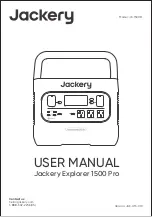
5
It is often desirable to trigger the unit at a sub-
multiple of the trigger source. Suppose you wish
to trigger a laser at 10 Hz synchronously with
the zero crossing of the power line. In this case
you would select the Line Trigger, and set
channel D's delay to 95 ms. Once triggered, the
DG535 will ignore other triggers until all
channels have timed out, hence every sixth Line
trigger (at 60 Hz) will cause a new timing cycle.
The RATE error LED on the front panel will be
illuminated to indicate that triggers occurred
while the unit was busy. Trigger rates up to
100 MHz can be used, with the unit ignoring all
triggers until all channels have timed out, as in
the above case.
DELAY MENUS
There are four delay menus to specify the delays
for channels A, B, C and D. Each delay may be
entered in floating point or exponential notation
or may be modified in the keypad cursor mode.
The maximum time delay is
999.999,999,999,995 seconds, which may be set
with a resolution of 5 ps.
Example Delay Menus
A=T0+0.123456789125
B=A+0.001000000000
C=T0+123.456789123455
D=C+0.000000010000
Any delay channel may be "linked" to another
channel. Two examples of this are shown in the
above sample menus. While A is referenced to
T0, channel B's delay is set to A's delay plus
0.001 seconds. Linking provides a convenient
method to specify a pulse output (AB) as a pulse
start time and width rather than start and stop
times. Now, if channel A's delay is modified, B's
delay moves with it, so that the pulse width
stays at 0.001 seconds. With the above settings,
the CD output will produce a very accurate 10
ns pulse despite the very long delay which is
specified for channel C.
To change the linkage, the cursor is positioned
beneath the character just to the right of the
equal sign, and the cursor up/down keys are
used to select from the available links. Not all
links are available, for example, in the above
menus linking channel A to channel B is not
allowed, as B is linked to channel A in the second
menu.
Delay can be scrolled by first selecting the delay
menu, positioning the cursor under the digit to be
incremented. Depress the #5 and either the up or
down keys simultaneously. The step rate will be
approximately 4 Hz, and may vary during a scan.
OUTPUT MENUS
The output menus are used to specify the load
impedances, pulse output amplitudes, offsets, and
polarities for each of the front panel BNC's. The
cursor (left/right) keys are used in the "top" line of
the OUTPUT menu to select which output is to be
programmed. Successive presses of the OUTPUT
key will access each menu line for the selected
output, finally returning to the "top" line.
The menu items for the T0, A, B, C and D output
are virtually identical. An example of these menus
is given here for channel A's output:
A:load= High Z
A:TTL NIM ECL VAR
A:Inverted Normal (if TTL, NIM or ECL is
selected)
A:Amplitude = +1.00V (if VARiable is selected)
A:Offset = 0.50V (if VARiable is selected)
The first line in this submenu specifies the load
impedance. The cursor (up/down) keys are used to
select between High Z and 50
Ω
loads. This is a very
important step in setting up the output: the wrong
choice will cause the output to have half the
expected amplitude, or to misbehave entirely.
The cursor (left/right) keys are used in the second
submenu to select either standard logic levels for the
output, or continuously variable offsets and
amplitudes. If either the TTL, NIM or ECL logic
levels are selected, the next submenu is used to
specify the polarity of the output pulse: the
"Normal" polarity will provide a rising edge at the
output at the set time: "Inverted" polarity will
provide a falling edge.
If VAR (variable) is selected in the second
submenu, then subsequent submenus allow the pulse
amplitude and offset to be set. Both numbers may be
entered as floating point numbers or may be
modified by the cursor keys. The minimum
















































